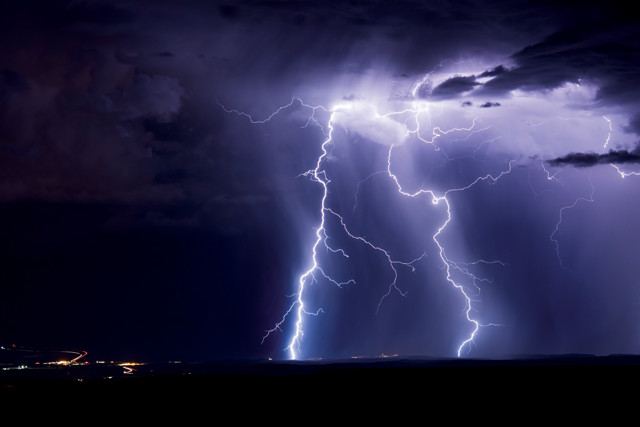
by Mary Caperton Morton Tuesday, October 16, 2018

New research links lightning to the 27-day solar rotational cycle. Credit: ©iStockphoto.com/mdesigner125.
The effects of solar cycles on Earth’s climate over timeframes of thousands of years are well documented, but the shorter-term effects on weather are less understood. A new study using ancient Japanese diaries to track storms in the 18th and 19th centuries suggests that one of the sun’s shortest cycles — the 27-day rotational period — may play a role in stimulating lightning on Earth.
Every 27 Earth days, the sun completes a full rotation about its axis. As the sun turns, sunspots, solar flares and coronal mass ejections can come into alignment with Earth, sometimes subjecting our planet to spikes in ultraviolet radiation and solar winds that can lead to increased storm activity on Earth. “The exact mechanisms that cause these changes [in Earth’s atmosphere] remain unknown, but we propose that the electrical properties of the air are somehow altered as the incoming charged particles collide with the atmosphere,” says Hiroko Miyahara, a physicist at Musashino Art University in Tokyo and lead author of the new study, published in Annales Geophysicae.
Miyahara and his colleagues turned to two diaries kept in Japan for a period spanning more than 200 years. A farming family in Hachioji, in what is now in the western part of Tokyo, kept the “Diary of the Ishikawa Family,” recording agricultural milestones such as plantings and harvests, natural disasters like fires and floods, and daily weather reports. The second diary, “Diary of Hirosaki Clan Government Office,” was kept by civil servants in Edo, in what is now central Tokyo.
“The advantage of using these diaries is that we can study the characteristics of meteorological phenomena for a more than 200-year period,” Miyahara says, “including periods when solar activity was much [stronger] or weaker than today.” The team looked for references to thunder and lightning between the months of May and September and found peaks in activity every 24 to 31 days — the window for increased sunspot exposure during the solar rotation.
“It’s pretty amazing that even using somewhat crude records such as centuries-old diaries, they can still see this 27-day signal,” says Chris Scott, an ionospheric physicist at the University of Reading in England, who was not involved in the new study. The study complements other published studies that have detected the 27-day solar rotational cycle in modern lightning records. Those records typically span less than a decade, however, while the new study is the first to offer a long-term look at these cycles, Scott says. “The more cycles you have, the better, statistically speaking,” for documenting such phenomena, he says.
The next step should be to use the Japanese diaries to assess whether they document weather patterns influenced by the sun’s 11-year sunspot cycle, Scott says. And, he notes, “we know from looking at ice-core and tree-ring data that the sun has even longer cycles that occur over hundreds of years. Anything we can use to tease out those relationships is really helpful.”
Improving our understanding of the mechanisms behind the sun’s influence on Earth’s weather is important, Scott says. “Solar winds don’t directly create lightning, they just enhance it. You still need the right storm conditions, such as convective instability and ice particles rubbing against one another, to generate lightning.”
The research may prove useful for weather forecasting, Miyahara says. “Solar wind streams rotate with the sun, sweeping past Earth at regular intervals, [sometimes enhancing the atmospheric conditions needed to generate lightning storms]. As these streams can be tracked by spacecraft, this offers the potential for predicting the severity of hazardous weather events many weeks in advance.”
© 2008-2021. All rights reserved. Any copying, redistribution or retransmission of any of the contents of this service without the expressed written permission of the American Geosciences Institute is expressly prohibited. Click here for all copyright requests.